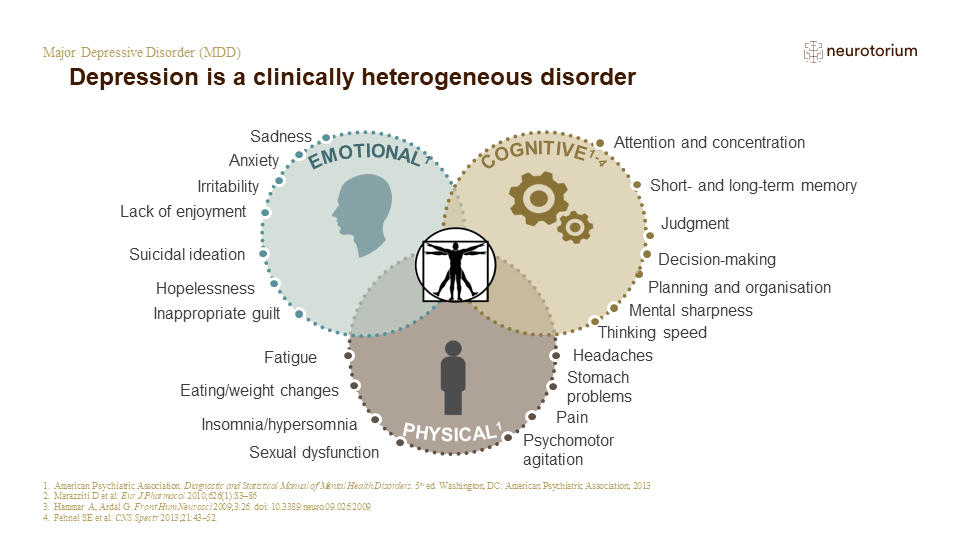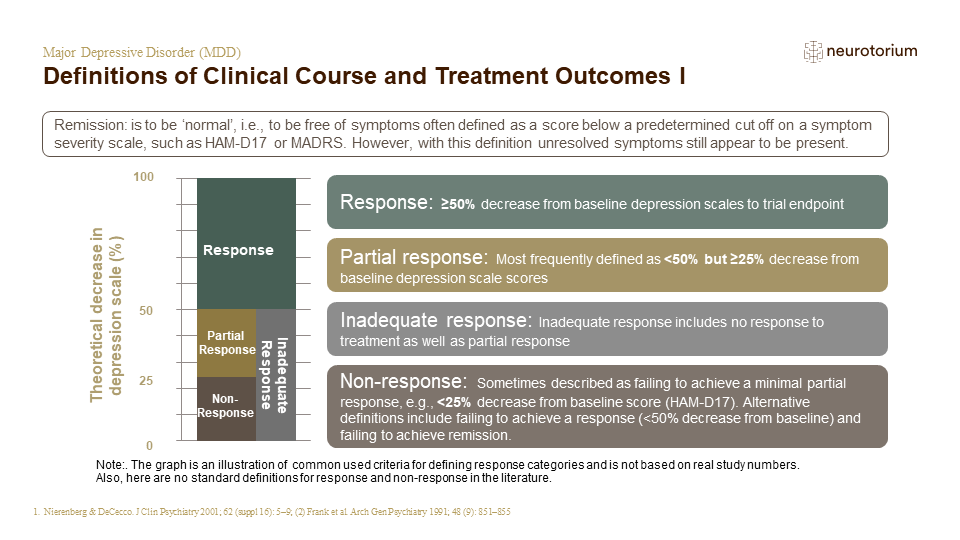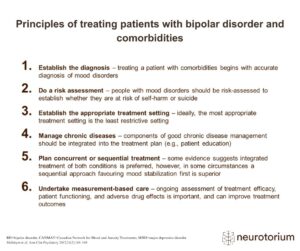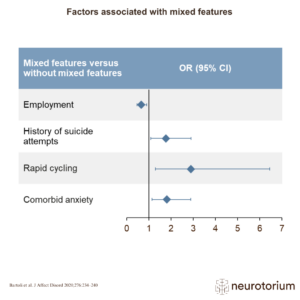Index for
slide deck
Title
-1024x576.jpg)
Course, Natural History and Prognosis
This slide covers course, natural history and prognosis of Major Depressive Disorder. It covers the definition for depression based on WHO’s ICD-10 classification system or the American Psychiatric Association’s DSM-IV and DSM-5 system.
Slide deck scheduled for review su…
-1024x576.jpg)
Depression
This slide shows core definitions for depression based on World Health Organization’s ICD-10 classification system or the American Psychiatric Association’s DSM-IV and DSM-5 system.
References:
NICE CG90. Depression in adults: recognition and management. 2009. Update Apri…
-1024x576.jpg)
Depression
Reference:
American Psychiatric Association. Diagnostic and statistical manual of mental disorders 5th edition: American Psychiatric Association. 2013

Depression is a clinically heterogeneous disorder
References:
American Psychiatric Association. Diagnostic and Statistical Manual of Mental Health Disorders. 5th ed. Washington, DC: American Psychiatric Association; 2013.
Jaeger J et al. Psychiatry Res 2006; 145: 39–48.
World Health Organization Depression Fact Sheet N3…
-1024x576.jpg)
Cognitive symptoms of depression have a negative impact on many aspects of the patient’s life
References:
McIntyre RS et al. Depress Anxiety 2013; 30(6): 515–527.
Hammar A, Ardal G. Front Hum Neurosci 2009; 3:26. doi: 10. 3389/neuro. 09. 026. 2009.
-1024x576.jpg)
MDD symptoms – American Psychiatric Association
The American Psychiatric Association (APA) describes nine depressive symptoms for diagnostic purposes.[APA, 2013]
Depressed mood
- Patients may describe their mood as depressed, sad, hopeless, discouraged, or ‘down in the dumps’.[APA, 2013] Alternatively, the patient may …
-1024x576.jpg)
MDD symptoms – The Montgomery-Åsberg Depression Rating Scale
The Montgomery–Åsberg Depression Rating Scale (MADRS), which was designed to be sensitive to the effects of antidepressants, includes ten depressive symptoms, six of which are described as ‘core symptoms’.[Montgomery & Asberg, 1979; Beck et al., 2002]
MADRS item 1. Appare…
-1024x576.jpg)
The course of MDD
The optimal outcome for a patient with major depressive disorder (MDD) is a full recovery from the major depressive episode and to never become depressed again.[Nierenberg & DeCecco, 2001] Treatment of MDD is divided into three phases, corresponding to different stages of…
-1024x576.jpg)
MDD is a complex, often recurrent and remitting disorder
Previous slide illustrates the typical course of illness for patients with depression; either receiving only acute-phase treatment or receiving longer-term treatment designed to prevent relapse. It also highlights that long-term treatment of depression with antidepressant…

Definitions of Clinical Course and Treatment Outcomes I
Source (slide):
Nierenberg et al. J Clin Psychiatry 2003; 64 (suppl 15): 13–17; page 13 (‘Remission, relapse, recurrence’ section)
Riso et al. J Affect Disord 1997; 43 (2): 131–142
Nierenberg & DeCecco. J Clin Psychiatry 2001; 62 (suppl 16): 5–9; page 8
Frank et al. Arc…
-1024x576.jpg)
Definitions of Clinical Course and Treatment Outcomes
MDD is a chronic disorder, most frequently characterised by relapses and recurrences.[Nierenberg et al., 2003] Relapse can be defined as an episode of MDD that occurs within 6 months of response or remission;[Nierenberg et al., 2003; Riso et al., 1997] theoretically, rela…
-1024x576.jpg)
MDD specifiers – I
References on the slide:
American Psychiatric Association. Diagnostic and Statistical Manual of Mental Disorders. Fifth Edition (DSM-5™). © American Psychiatric Association, 2013.
American Psychiatric Association. Diagnostic and Statistical Manual of Mental Disorders. Fou…
-1024x576.jpg)
MDD specifiers – II
References on the slide:
American Psychiatric Association. Diagnostic and Statistical Manual of Mental Disorders. Fifth Edition (DSM-5™). © American Psychiatric Association, 2013.
Oxford Concise Medical Dictionary. Second Edition. © Oxford University Press, 1998.
-1024x576.jpg)
MDD specifiers – III
References on the slide:
American Psychiatric Association. Diagnostic and Statistical Manual of Mental Disorders. Fifth Edition (DSM-5™). © American Psychiatric Association, 2013.
Oxford Concise Medical Dictionary. Second Edition. © Oxford University Press, 1998.
-1024x576.jpg)
MDD specifiers – IV
References on the slide:
American Psychiatric Association. Diagnostic and Statistical Manual of Mental Disorders. Fifth Edition (DSM-5™). © American Psychiatric Association, 2013.
Oxford Concise Medical Dictionary. Second Edition. © Oxford University Press, 1998.
-1024x576.jpg)
MDD specifiers – V
References on the slide:
American Psychiatric Association. Diagnostic and Statistical Manual of Mental Disorders. Fifth Edition (DSM-5™). © American Psychiatric Association, 2013.
American Psychiatric Association. Diagnostic and Statistical Manual of Mental Disorders. Fou…
-1024x576.jpg)
Depression – DSM-5: Updates from DSM-IV
Highlights of Changes from DSM-IV-TR to DSM-5. American Psychiatric Association 2013. Available from: https://www.psychiatry.org/dsm5. Accessed April 2016.
While bereavement may precipitate major depression in people who are especially vulnerable (i.e. they have already s…
-1024x576.jpg)
Recurrent Brief Depressive Disorder
References:
American Psychiatric Association (1994)
Angst et al (1990)
-1024x576.jpg)
Subsyndromal symptoms of Unipolar Depression and Bipolar Depression
References:
Howarth et al (1992)
Johnson et al (1992)
Judd et al (1994)
-1024x576.jpg)
Differential diagnosis
Differential diagnosis is the distinguishing of a disorder from others presenting with similar signs and symptoms.
Manic episodes with irritable mood; mixed episodes (bipolar disorder)
Major depressive episodes with prominent irritable mood may be difficult to distinguis…


-1024x576.jpg)
-1024x576.jpg)
-1024x576.jpg)
-1024x576.jpg)
-1024x576.jpg)
-1024x576.jpg)
-1024x576.jpg)
-1024x576.jpg)
-1024x576.jpg)
-1024x576.jpg)
-1024x576.jpg)
-1024x576.jpg)
-1024x576.jpg)
-1024x576.jpg)
-1024x576.jpg)
-1024x576.jpg)
-1024x576.jpg)
-1024x576.jpg)


